The Client, a supplements company, needed to increase sales effectively without cannibalizing or duplicating their existing efforts. Their primary challenge was expanding their marketing investment efficiently to create more awareness, while maintaining the effectiveness of their campaigns through a coordinated nurture strategy.
Goals and Objectives
The Client aimed to:
- Increase ad spend by 50% while maintaining efficiency (measured by a Total Return on Ad Spend (ROAS) of $5).
- Increase revenue proportionally with increased ad spend.
- Improve repeat purchase rate by 50%.
Strategy
To tackle this challenge, FrontRow Group teamed up with Ampd to create an integrated Google to Amazon strategy aimed at:
- Using Google Ads to drive NTB customers to The Client' Amazon storefront.
- Increasing impressions and conversions using a variety of Amazon Ads products.
- Retargeting with Amazon Ads to nurture shoppers into customers through a multi touch engagement strategy.
- Identifying the most effective combination and number of touchpoints needed to drive conversions.
Key Marketing Channels and Tools
The consumer buying journey can be long and complex. After a trigger event that starts their purchase journey, consumers spend time researching prior to actually purchasing. For this reason, it’s vital for brands to engage potential customers throughout the awareness, research and purchasing stages of their buying journey. By leveraging multiple channels and touchpoints, brands can engage potential consumers at and throughout each stage, with each touchpoint building more momentum to the customer choosing their brand and product.
Here are some of the channels that Front Row invested in:
- Amazon Sponsored Products: Engaged potential customers searching for products, providing quick results and a strong direct ROAS.
- Amazon Sponsored Brands: Increased brand visibility during searches. Though it showed a lower ROAS on its own, it was part of a broader strategy.
- Sponsored Brand Video: Used as a strong traffic driver to increase engagement.
- Sponsored Display: Targeted lookalike audiences and retargeted potential customers who had visited product pages.
- Amazon DSP: Focused on prospecting new customers and nurturing those who had already engaged.
- Amazon Ads API: Enabled engagement of Google Ads shoppers, converting them to Amazon customers and providing performance data to optimize campaigns.
- Stores: Directed traffic from Google and Sponsored Brand Ads to Amazon Stores, boosting conversions, brand recognition, and loyalty.
Best Practices for Implementing a Multichannel Marketing Mix
- Strengthening the Entire Funnel
- Create multiple touchpoints to engage potential customers throughout their buying journey.
- Target Additional New-to-Brand (NTB) Volume
- Use platforms like Google to attract new shoppers and guide them through the sales funnel.
- Enhancing Customer Nurturing
- Focus on improving repeat purchases and increasing subscriptions to maintain customer loyalty.
- Diversifying Marketing Channels
- Invest in various channels to engage customers at different stages of their decision-making process.
- Measuring Efficiency
- Use tools like Amazon Marketing Cloud to analyze touchpoint frequency, ROAS, and other key metrics.
Measurement and Optimization
Amazon Marketing Cloud (AMC) and customer journey analysis:
- Utilized AMC Instructional Queries and custom queries to pull insights on touchpoint frequency, ROAS, and layered ROAS across ad types.
- Found that while 22% of orders were completed with 4 touch points or less, 51% required 15+ touchpoints, indicating a need for more frequent engagements.
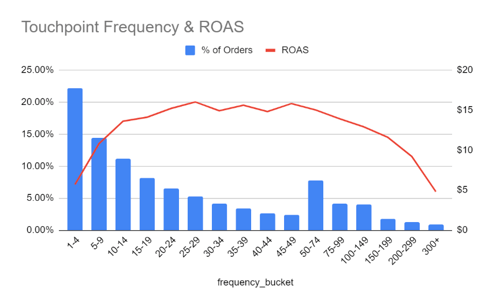
Insights from AMC data led to increased marketing efforts, revealing that coordination across Amazon Ads products improved ad sp$$$end efficiency.
Below you can see the ROAS on the Y axis when customers saw ads from different channels. ROAS was most efficient when customers saw ads from both DSP and Sponsored products, and while the combination of DSP, Sponsored Brand (SB), Sponsored Display (SD) and Sponsored Products (SP) had the least efficiency, it also had the highest reach.
Additionally, this reveals that while costs are higher when customers engage with multiple ads before purchase, this reveals that even with the higher cost, there is still strong efficiency due to the additional revenue generated, that otherwise would have gone unrealized without multiple touchpoints.
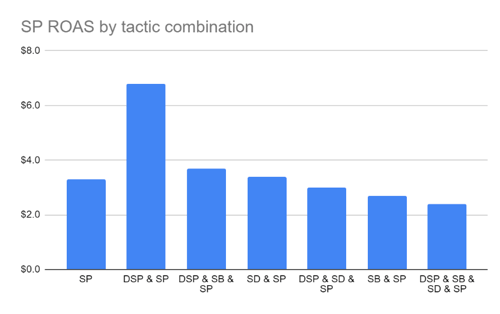
Results:
- Revenue: Increased by 139%.
- Total ROAS: Improved by 59% from $5 to $7.94.
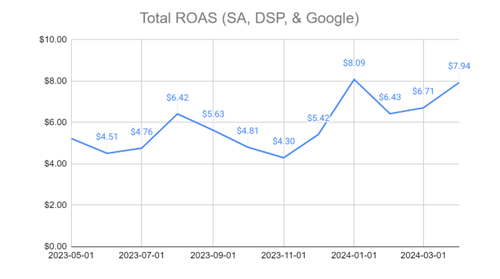
- Repeat Purchases: Increased by 86%, with significant improvements in Subscribe and Save sales and active subscriptions.
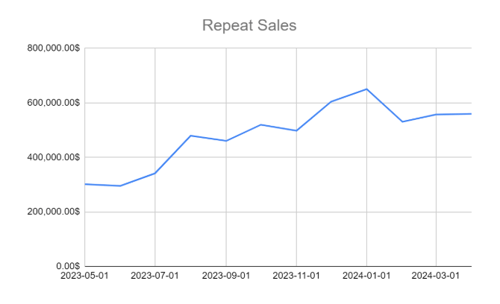
- Detail Page Views (DPV): Increased by 33.86%.
- Detail Page View Rate (DPVR): Increased by 14.78%.
- New-to-Brand (NTB) Customers: 78% of conversions from Google were NTB, significantly higher than from other channels.
- Growth in Branded Keyword Searches: "megasporebiotic" search volume increased by 109%.
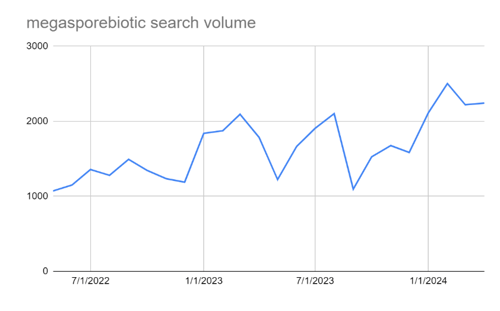
Using the insights and results from this campaign, the strategy can be replicated for other brands. Data across other products and brands reveals that Google Ads delivers an average of 72% NTB customers. While NTB data on Amazon Ads is limited, this study revealed NTB on Amazon Ads was 30%. It is reasonable to conclude that if you are looking for NTB customers Google Ads is likely a strong candidate.
Conclusion
This case study demonstrates the power of a comprehensive, multichannel marketing strategy. By integrating efforts across Google Ads, Amazon Ads, and other platforms, businesses can drive significant growth, improve customer retention, and achieve higher marketing efficiency. This whitepaper provides a roadmap for leveraging a multichannel marketing mix to maximize impact and ROI.
If you want help implementing external Ads into your Amazon growth plan please reach out to info@ampd.io.
If you want help implementing on Amazon Ads and coordinating your marketing mix, please reach out to www.FrontRowGroup.com.